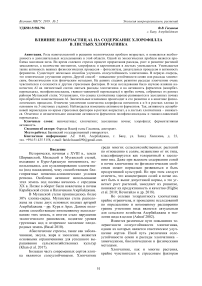Влияние наночастиц Al на содержание хлорофилла в листьях хлопчатника
Автор: Гасанова Ф.В.
Журнал: Вестник Нижневартовского государственного университета @vestnik-nvsu
Рубрика: Экология микроорганизмов, растений
Статья в выпуске: 2, 2019 года.
Бесплатный доступ
Роль нанотехнологий в решении экологических проблем возрастает, и появляется необходимость в дополнительных исследованиях в этой области. Одной из экологических проблем является проблема засоления почв. Во время солевого стресса процент прорастания рассады, рост и развитие растений замедляются, а количество пигментов, хлорофилла и каротиноидов в листьях уменьшается. Уменьшается также активность важных физиологических процессов - фотосинтеза, дыхательных процессов и активность ферментов. Существует несколько способов улучшить солеустойчивость хлопчатника. В первую очередь, это генетическое улучшение сортов. Другой способ - повышение устойчивости семян или рассады химическим, биологическим или физическим методами. На ранних стадиях развития рассады хлопчатник очень чувствителен к солености и другим стрессовым факторам. В ходе исследования было изучено влияние наночастиц Al на пигментный состав листьев рассады хлопчатника и на активность ферментов (аскорбат-пероксидазы, полифенолоксидазы, гваякол-зависимой пероксидазы) в пробах почвы, собранных из разных районов Муганской степи...
Наночастицы, хлопчатник, засоленные почвы, хлорофилл, ферментативная активность
Короткий адрес: https://sciup.org/14117150
IDR: 14117150 | УДК: 581.5:582.796 | DOI: 10.36906/2311-4444/19-2/07
Текст научной статьи Влияние наночастиц Al на содержание хлорофилла в листьях хлопчатника
Исторически, начиная с XVIII в., земли Ширванской, Мильской и Муганской степей, входящие в Кура-Аразскую низменность, использовались для культивирования хлопчатника (под насаждения), чему способствовали благоприятные почвенно-климатические условия региона. Особенно активное использование этих земель под посевы началось с середины XX в. Позже в оборот были вовлечены и почвы Карабахской степи и Нахичевани Азербайджана.
В Муганской степи производилось более 30% хлопка-сырца. Муганская степь расположена на стыке двух основных водных артерий Азербайджана - рр. Кура и Араз. Данное положение способствовало интенсивному использованию этих земель, и итогом стало нарушение экологического равновесия, поднятие уровня грунтовых вод и вторичное засоление плодородных земель (Basal 2010).
Абиотические стрессы, такие как заболачивание, засуха, жара и засоление, являются основными ограничениями для успешного выращивания сельскохозяйственных культур (Khan et al. 2017). " '
Большая часть современных сортов хлопка являются солеустойчивыми. Хлопчатник среди многих сельскохозяйственных растений по отношению к солям, независимо от их типа, классифицируется как толерантный к засолению вид. Даже при высоком содержании солей в почве хлопчатник по физиологическим свойствам может нормально развиваться и быть продуктивной культурой. Но при этом следует отметить, что концентрация солей в почве может быть и выше допустимой нормы, а это угнетает рост растений, замедляет их развитие, понижает их продуктивность и качество (Higbie et al. 2010; Нечитайло и др. 2018).
Но солевая толерантность хлопчатника крайне ограничена, и проведение исследований по определению и возможному расширению границ угнетения вида является актуальным для сельского хозяйства Азербайджана и экологии вида в целом (Ashraf 2002).
Имеются различные пути повышения толерантности солеустойчивости хлопчатника, одним из которых является генетическое улучшение сортов. Иной путь увеличения солеустойчивости семян и рассады хлопчатника -химическими, биологическими и физическими методами.
Хлопчатник, как и многие растения, крайне чувствителен к стрессовым факторам внешней среды в фазах всхода и цветения. Растения, успешно преодолевшие все негативные (природные и антропогенные) условия воздействия в период своей вегетации, даже в засоленных почвах, способны дать хороший урожай (Cavalcanti et al. 2007).
У большинства возделываемых растений, в частности у хлопчатника, при солевом стрессе наблюдается замедление развития, резкое уменьшение количества пигментов, хлорофиллов и каротинов в листьях, снижается активность фотосинтеза и ферментов (Basal 2010).
W.Chen, Z.Hou, L.Wu, Y.Liang, C.Wei (2010) установили, что хлопчатник в начальной фазе развития наиболее чувствителен к солевым стрессам, нежели в других фазах своего вегетационного периода. В своей работе «Влияние солености и азота на рост хлопка в аридной среде» они отмечают, что рост хлопка, измеренный как высота растения, значительно зависел от засоления почвы и взаимодействия N-солености, но не только от N. При более высокой солености поглощение N не зависит от уровня N и в основном зависит от засоленности почвы. Поглощение К уменьшалось с засолением почвы. Концентрация Na, Cl и Са в растительных тканях увеличивалась с засолением почвы с самыми высокими концентрациями в хлопковом листе.
Высокое содержание солей в почве, замедляя интенсивность развития хлопчатника, угнетает его всходы, значительно уменьшает фитомассу (как надземную, так и подземную), листья изменяют свой цвет - чернеют (Gouia et al. 1994).
Опыты, проведенные на четырех сортах хлопчатника ^Gossypium hirsutum L.) на несколько приподнятых участках рельефа, показали, что рост их всходов, длина корней, количество и общая площадь листьев, количество хлорофиллов, осмотический потенциал, сухая фитомасса и др. показатели на засоленных почвах серьезно уступают растениям, возделываемым в нормальных условиях. В зависимости от сорта хлопчатника изменяется и степень подверженности к солевым стрессам. При влиянии стрессовых факторов среды, в частности солей, наличие хлорофиллов непосредственно зависит от генотипа самого растения - хлопчатника. Установлена прямая связь между антиоксидантами и солеустойчивостью хлопчатника (Ashraf 2002; Mittler 2002; Saleh 2012).
После стрессов активность антиоксидантных ферментов, которые значительно уменьшают повреждения при окислении, играет значительную роль после солевого стресса (Cavalcanti et al. 2007).
Объект и методика исследований
Опыты проведены на сорте хлопчатника «Гянджа-110», который районирован в 2017 г. и получен путем мутагенеза. В экспериментах были использованы наночастицы А1. В настоящее время наиболее используемыми наноматериалами в сельском хозяйстве являются наномембраны, нанопористые полимеры, нанопори-стые цеолиты, углеродные нанотрубки для наносенсоров и каталитические наночастицы для удаления загрязняющих веществ из окружающей среды (Casarez-Santiago et al. 2019, Ruotolo R. etal. 2018).
Семена хлопчатника были представлены Институтом генетических ресурсов Национальной Академии наук Азербайджана.
Семена хлопчатника до посадки были очищены от волокон. «Гянджа-110» является скороспелым сортом, высота растения - 90-110 см, кусты компактны, пирамидальной формы, моноподиальные ростки - 1 шт., стебель увядший, зеленого цвета, слабо волокнистый, устойчив к полеганию. Коробочки яйцеобразнокрупные, звездовидные, гладкие с бурыми пятнами и зеленого цвета. Урожай устойчив. Семена средне-крупные, масса 1000 семян - 115120 г, темно-зеленого цвета, средне-щетинистые (Гумбатов, Халилов 2012).
Ферментативная активность определялась стандартным биохимическим методом.
Активность аскорбат-пероксидазы определялась уменьшением оптической плотностью при 265 мм волн аскорбиновой кислоты, т. к. степень окисления аскорбиновой кислоты напрямую коррелируетя количеством ферментов.
Для определения активности фермента аскорбинатоксидазы спектоскопическим методом использован фосфатный буфер (pH 7,37,4), 10"3М MgSO4 на 10"5М раствора аскорбиновой кислоты.
В фазе 3-х листьев хлопчатника с каждого варианта взяты образцы в количестве 1 ±0,001 г, которые были промыты в дистиллированной воде и растерты в ступке. Полученный гомогенат был растворен в колбе объемом 50 мл в охлажденном буфере фосфата (25 мл). Экстракт осаждался в центрифуге в течение 10 мин (скорость вращения 9 000 об/мин). В кювету (опыт) вносили 1 мл MgSO4, 2 мл фосфатного буферного раствора, 0,1 мл фильтрата и 0,7 мл аскорбиновой кислоты.
В другую кювету (контроль) в том же количестве были размещены аналогичные компоненты, но аскорбиновая кислота была заменена 0,7 мл Н2О.
Для каждой кюветы начальной точкой определений принимался ноль. Продолжитель- ность первого определения - 30 с, затем через 60 с - 5-6 мин. Активность ферментов (А) определялась по следующей формуле:
(Р2~ Dj)60W2
" (t^tJ^H где D, - оптическая плотность раствора в начальной стадии (первое определение), D2 — оптическая плотность раствора в конце опыта, 1Щ t2 — время в начале и в конце опыта, Н - масса взятых образцов (г), V - масса экстракта фермента (мл), необходимый объем для проведения реакции (мл).
Для определения активности ферментов полифенолоксидазы и гваякол-зависимой пероксидазы спектрофотометрическим методом был спользован метод определения активности фермента аскорбат-пероксидазы. В этих опытах использованы 0,5 г листового материала и 10 мл 0,06 М фосфатного буферного раствора (pH 7,2). '
Определителем являлись растворы 0,02% полифенолоксидазы и диэтилпарафенилендиамина (Ермаков и др. 1987). Спектры флуоресценции строились на спектрофотометре Сагу Eclipse (Varian Cary).
Степень засоленности и pH почв определялись в лаборатории органических удобрений Института почвоведения и агрохимии НАНА кондуктометром (ЕС-метр).
Почвенные образцы были взяты из различных точек Муганской степи.
Семена хлопчатника были посажены в вегетационные емкости с почвой различной степени засоленности. В каждую вегетационную емкость размещали по 10 семян сорта «Гянджа-110» в 4 вариантах, проращивание проводилось в фитотроне с автоматическим регулированием температуры, света и влажности (рис. 1,2).
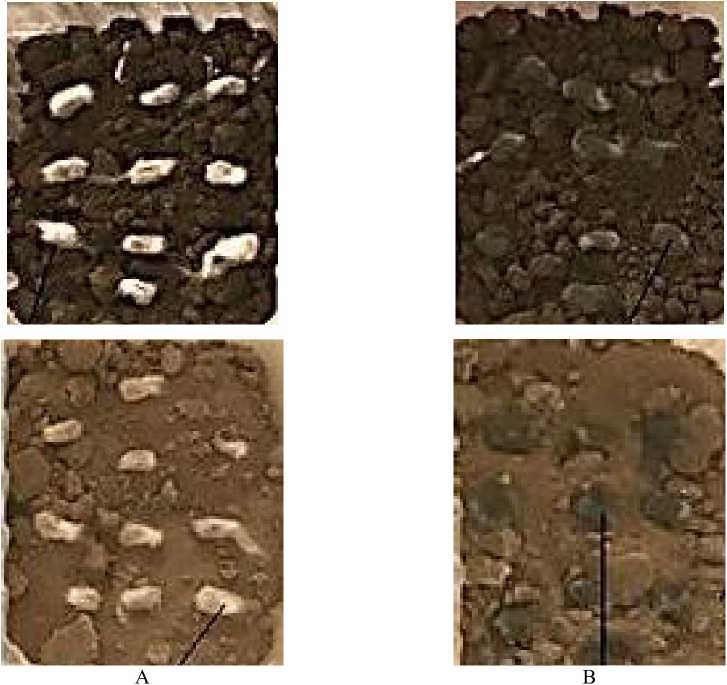
Рис. 1. Посадка семян хлопчатника в вегетационных емкостях: А - вариант, не обработанный наночастицами, В - вариант с А1 наночастицами

Рис. 2. Всходы семян хлопчатника: А - вариант, не обработанный наночастицами, В - вариант с А1 наночастицами
Результаты и их обсуждение
В проведенных опытах на генетически усовершенствованном сорте хлопчатника определялось влияние наночастиц А1 на рост стебля, длину корней, их плотность и биомассу. Выявлено, что при низкой концентрации наночастиц А1 существенных изменений в минеральном питании и развитии корневой массы,а также всходов не наблюдалось. Но при этом установлено положительное влияние наночастиц А1 на поглощение элементов Fe и Na и ингибирование продуктов некоторых фитогормонов. Под действием наночастиц А1 концентрация IPA предотвращает ускоренное старение растений. По мере увеличения концентрации наночастиц в корневой системе рассады увеличивается количество А1.
Анализы образцов корней и листьев свидетельствуют о накоплении в корнях и листьях наночастиц, что подтверждается и работами зарубежных авторов, которые показали, как наночастицы транспортировались от корней к побегам через сок ксилемы (Rui et al. 2014).
Проанализирована фитотоксичная эффективность наночастиц на Bt-трансген хлопчатника и выявлено, что наночастицы А1 от корней хлопчатника распространяются по стеблю к листьям, абсорбируются на поверхность хлоропластов, в связи с чем происходит разрушение хлоропластов. С другой стороны наночастицы в массе ксилем способствуют уменьшению количества ростовых гормонов IAA и АВА, таких важных элементов как Zn, Mg, Fe и Р. Наночастицы А1 не оказывают существенного влияния на активность довольно важного фермента пероксидазы в клетках корней и супероксиддисмутазы в клетках листьев. Но при этом они способны значительно изменить активность фермента каталазы (CAT).
При наличии наночастицы Bt-transgen (биостимулятор, активизирующий развитие листьев растений) в клетках корней и листьев хлопчатника в концентрации 100 mg/1 активность фермента каталазы по сравнению с контролем существенно различна. Активность ка талазы в обычном хлопчатнике, по сравнению с Bt-transgen, несколько ниже, а на образцах, семена которых обработаны наночастицами А1, его активность значительно увеличивается.
Для определения кинетики изменения пигментов хлорофилла при помощи спектров флюорессенции использовались почвенные образцы с различной степенью засоления: почва I - 2,32 dS/m, почва II 0,44 dS/m, почва V-0,56dS/m и почва VI- 1,10 dS/m. pH водной суспензии во всех образцах - 6,5-7, от слабо кислой до нейтральной.
В контрольном варианте семена хлопчатника не обработаны наночастицами А1, а в экспериментальном варианте - обработаны. На 3листной стадии развития хлопчатника были взяты образцы листьев шириной 3 мм и длиной 1 см, после удерживания их в течении 1 ч в темноте были сняты спектры флюорессенции. В результате было зафиксировано 2 максимума в спектре флюорессенции хлорофиллов при комнатной температуре в листьях in vivo: первый максимум спектра в красной области длиной волны 689 нм относится к II фотосистеме (PSII), второй (720-740 нм) - к I фотосистеме (PSI). ‘
За показатели количества хлорофилла в опытах приняты соотношения F689/F740. Установлена обратная связь между соотношением F685/F740 и количеством хлорофиллов (Hak et al. 1990). Составляя спектры флюорессенции и проводя расчеты максимумов этих соотношений, можно наблюдать те или иные стрессовые факторы, влияющие на кинетику изменения количества хлорофиллов в листьях растений. На основе проведенных исследований были составлены и сопоставлены кривые спектров флюорессенции рассады семян хлопчатника, обработанных наночастицами А1, на засоленных и плодородных почвах (рис. 3). На рисунке представлены спектры флюорессенции всходов семян в почвенных образцах, обработанных наночастицами Al (I сосуд) (кривая 2), и спектры семян на необработаном (KI сосуд) контрольном варианте почв (кривая 1).
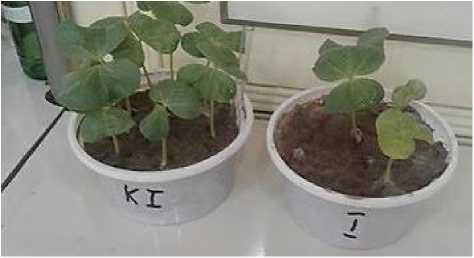
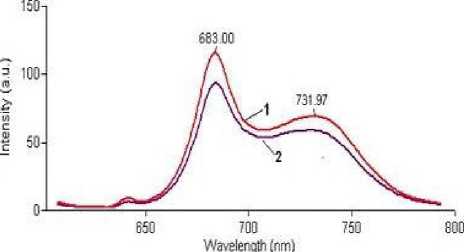
Рис. 3. Спектр флюорессенции рассады семян, обработанных А1 наночастицами (I емкость) (кривая 2), и спектр флюорессенции рассады не обработанных А1 наночастицами семян (емкость KI) (кривая 1)
На рисунке 4 представлены спектры листьев растений из второго образца почв, на рисунке 5 — спектры из пятого образца почв, а на рисунке б - из шестого образца почв. В резуль- листьях всходов семян, обработанных наночастицами А1, на засоленных почвах (образец I) интенсивность максимумов уменьшилась по сравнению с контролем.
тате проведенных опытов установлено, что на
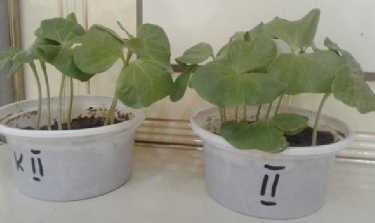
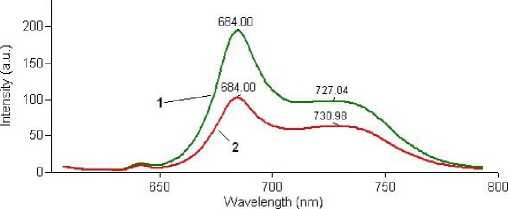
Рис. 4. Спектр флюорессенции рассады семян, обработанных А1 наночастицами (II емкость) (кривая 1), и спектр флюорессенции рассады не обработанных А1 наночастицами семян (емкость KI) (кривая 2)
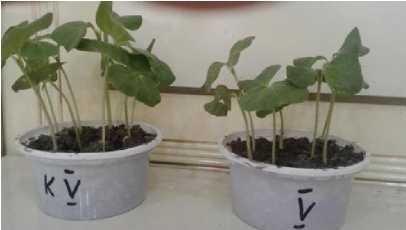
Рис. 5. Спектр флюорессенции рассады семян, обработанных А1 наночастицами (V емкость) (кривая 2), и спектр флюорессенции рассады не обработанных А1 наночастицами семян (емкость KV) (кривая 1)
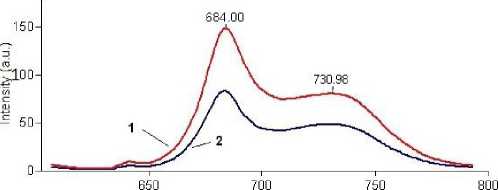
Wavelength (nm)
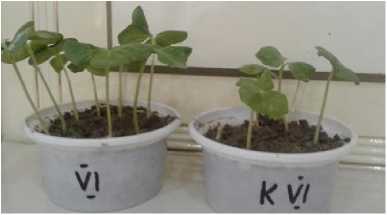
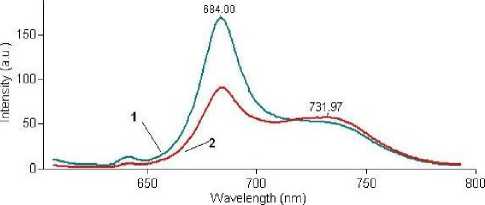
Рис. 6. Спектр флюорессенции рассады семян, обработанных А1 наночастицами (VI емкость) (кривая 2), и спектр флюорессенции рассады не обработанных А1 наночастицами семян (емкость KVI) (кривая 1)
Если соотношение максимумов спектров флюорессенции на не обработанных наночастицами семенах составило F683/732 = 1,58, то на обработанных семенах это соотношение соответствует F683/732 = 1,64. Уменьшение данного соотношения свидетельствует, что А1 наночастицы на засоленных почвах способствуют увеличению количества хлорофилла. Данное соотношение на слабозасоленных почвах (образец VI) соответствует F684/732 = 1,78, а на контроле F684/732 = 1,84.
В данном варианте также наблюдается уменьшение соотношения F684/732, что еще раз свидетельствует о том, что при обработке семян наночастицами А1 увеличивается количество хлорофиллов на слабо засоленных почвах. В образцах почв II и V происходит увеличение соотношения F684/732. В контрольном варианте (почва КП) это соотношение составляло 1,8, а в экспериментальном варианте (почва II) - 2,0; в контольном варианте (почва KV) - 1,6, в экспериментальном (почва V) - 1,88. Следовательно, в образцах опресненных почв А1 наночастицы уменьшают наличие хлорофиллов.
Опыты показали, что при засоленности (солевой стресс) почв происходит уменьшение количества хлорофиллов в растениях, что подтверждают и другие исследователи (Taffouo et al. 2010). При увеличении концентрации NaCl в различных сортах сои зафиксировано уменьшение хлорофиллов на 52%. Уменьшение количества хлорофиллов и других пигментов при увеличении засоленности в Lens calinaris L. показано в работе (Turan et al. 2007). В наших опытах с обработкой семян хлопчатника наночастицами А1 наблюдался обратный процесс, т. е. при увеличении засоленности почв происходило увеличение количества хлорофилла в растениях хлопчатника.
Для определения активности ферментов аскорбат-пероксидазы, полифенолоксидазы, гваякол-зависимой пероксидазы в заложенных опытах были получены кривые спектра флюорессенции (рис. 7). Аскорбат пероксидаза в хлоропластах Н2О2 является основным ферментом цикла детоксикации askorbat-qultation (Asada 1992). Данный фермент и система askorbat-qultation играют важную роль не только в хлоропластах, но также в угасании активных радикалов кислорода в цитоплазме, митохондриях и пероксисомах (Rinderle, Lichtenthaler 1988).

Рис. 7. Ферментативная активность в листьях рассады семян, обработанных А1 наночастицами (TI, TH, TVI) и не обработанных А1 наночастицами (TKI, ТКП, TKVI)
Усиление факторов стресса среды способствует пропорциональному увеличению активности ферментов (Taibi et al. 2016). В проведенных опытах было выявлено,что в почвах с относительно высокой степенью засоленности (2,32 dS/m) в семенах, обработанных А1 наночастицами, происходит уменьшение активности фермента аскорбат-пероксидазы в листьях рассады хлопчатника, а в почвах с относительно низкой засоленностью (1,10 dS/m) их активность увеличивается в два раза.
Активность фермента полифенолоксидазы во всех почвенных образцах не существенна, но подвержена уменьшению.
Активность гваякол-зависимой пероксидазы в засоленных почвах (2,32 dS/m) уменьшается, но в относительно слабо засоленных почвах (1,10 dS/m) наблюдается существенное увеличение (рис. 7).
Заключение
Итак, семяна хлопчатника, обработаные А1 наночастицами, достаточно успешно произрастают в засоленных почвах. В динамике и кинетике физиологических процессов происходят существенные изменения: увеличение количества хлорофиллов и других пигментов
(особенно в 3-листовой фазе); изменение активности ферментов.
А при обработке семян А1 наночастицами в засоленных почвах в листьях хлопчатника происходит угасание активности ферментов: уменьшение активности фермента не существенно в полифенолоксидазе и ярко выражено в гваякол-зависимой пероксидазе.
Список литературы Влияние наночастиц Al на содержание хлорофилла в листьях хлопчатника
- Гасанова Ф. В. 2019. Влияние наночастиц на физиологические характеристики и активность ферментов растений, выращенных в соленых почвах // Бюллетень науки и практики 5:2, 142-151. DOI: 10.33619/2414-2948/39/19
- Гумбатов X. Г., Халилов Е. И. 2012. Технология волокна хлопчатника. Баку: Нурлан.
- Ермаков А. И., Арасимович В. В., Ярош Н. П., Перуанский Ю. В., Луковникова Г. А., Иконникова М. И. 1987. Методы биохимического исследования растений. Изд. 2-е, перераб. и доп. Ленинград: Колос. Ленингр. отд-ние, 44-45.
- Нечитайло Г. С., Богословская О. А., Ольховская И. П., Глущенко Н. Н. 2018. Влияние наночастиц железа, цинка, меди на некоторые показатели роста растений перца // Российские нанотехнологии 13:3-4, 57-63.
- Ahmad S., Khan N., Iqbal M. Z., Hussain A., Hassan M. 2002. Salt tolerance of cotton (Gossypium hirsutum L.) // Asian Journal of Plant Sciences 1:6, 715-719. DOI: 10.3923/ajps.2002.715.719
- Asada K. 1992. Ascorbate peroxidase-a hydrogen peroxide-scavenging enzyme in plants // Physiologia Plantarum 85: 2, 235-241.
- DOI: 10.1111/j.1399-3054.1992.tb04728.x
- Ashraf M. 2002. Salt Tolerance of Cotton: Some New Advances // Critical Reviews in Plant Sciences 21:1, 1-30.
- DOI: 10.1080/0735-260291044160
- Basal H. 2010. Response of cotton (Gossypium hirsutum L.) genotypes to salt stress // Pakistan Journal of Botany 42, 505-511.
- Cásarez-Santiago R. G. et al. 2019. Nanoagriculture and Energy Advances // Plant Nanobionics Springer, Cham, 141-164.
- DOI: 10.1007/978-3-030-12496-0_7
- Cavalcanti F. R., Lima J. P. M. S., Ferreira-Silva S. L., Viégas R. A., Silveira J. A. G. 2007. Roots and leaves display contrasting oxidative response during salt stress and recovery in cowpea // Journal of plant physiology 164(5), 591-600. URL: 10.1016/j.jplph. (2006. 03.04).
- DOI: 10.1016/j.jplph.(2006.03.04)
- Chen W., Hou Z., Wu L. et al. 2010. Effects of salinity and nitrogen on cotton growth in arid environment // Plant and Soil. Plant Soil 326, 61. URL:
- DOI: 10.1007/s11104-008-9881-0
- Gouia H., Ghorbal M. H., Touraine B. 1994. Effects of NaCl on flows of N and mineral ions and on NO3-reduction rate within whole plants of salt-sensitive bean and salt-tolerant cotton // Plant Physiology 105: 4, 1409-1418.
- Hák R., Lichtenthaler H. K., Rinderle U. 1990. Decrease of the chlorophyll fluorescence ratio F690/F730 during greening and development of leaves // Radiation and environmental biophysics 29:4, 329-336.
- DOI: 10.1007/BF01210413
- Higbie S. M., Wang F., Stewart J. M., Sterling T. M., Lindemann W. C., Hughs E., Zhang J. 2010. Physiological response to salt (NaCl) stress in selected cultivated tetraploid cottons // International Journal of Agronomy.
- DOI: 10.1155/2010/643475
- Khan A. et al. 2017. Nitrogen fertility and abiotic stresses management in cotton crop: a review // Environmental Science and Pollution Research 24:17, 14551-14566.
- DOI: 10.1007/s11356-017-8920-x
- Le Van Nhan, Chuanxin Ma, Yukui Rui1 et al. 2015. Phytotoxic Mechanism of Nanoparticles: Destruction of Chloroplasts and Vascular Bundles and Alteration of Nutrient Absorption // Scientific Reports 5, 11618.
- DOI: 10.1038/srep11618
- Mittler R. 2002. Oxidative stress, antioxidants and stress tolerance // Trends in plant science 7:9, 405-410.
- DOI: 10.1016/S1360-1385(02)02312-9
- Rinderle U., Lichtenthaler H. K. 1988. The chlorophyll fluorescence ratio F690/F735 as a possible stress indicator // Applications of Chlorophyll Fluorescence in Photosynthesis Research, Stress Physiology, Hydrobiology and Remote Sensing Springer, Dordrecht, 189-196.
- DOI: 10.1007/978-94-009-2823-7_23
- Rui Y., Gui X., Li X., Liu S., Han Y. 2014. Uptake, transport, distribution and bio-effects of SiO 2 nanoparticles in Bt-transgenic cotton // Journal of nanobiotechnology 12:1, 50.
- DOI: 10.1186/s12951-014-0050-8
- Ruotolo R. et al. 2018. Plant response to metal-containing engineered nanomaterials: an omics-based perspective // Environmental science & technology. 52:5, 2451-2467. 10.1021 / acs.est.7b04121.
- DOI: 10.1021/acs.est.7b04121
- Saleh B. 2012. Salt stress alters physiological indicators in cotton (Gossypium hirsutum L.) // Soil & Environment 31:2, 113-118.
- Taffouo V. D., Wamba O. F., Youmbi E., Nono G. V., Akoa A. 2010. Growth, yield, water status and ionic distribution response of three bambara groundnut (Vigna subterranean (L.) verdc.) landraces grown under saline conditions // International Journal of Botany 6:1, 53-58.
- DOI: 10.3923/ijb.2010.53.58
- Taïbi K., Taïbi F., Abderrahim L. A., Ennajah A., Belkhodja M., Mulet J. M. 2016. Effect of salt stress on growth, chlorophyll content, lipid peroxidation and antioxidant defence systems in Phaseolus vulgaris L // South African Journal of Botany 105, 306-312.
- DOI: 10.1016/j.sajb.2016.03.011
- Turan M. A., Turkmen N., Taban N. 2007. Effect of NaCl on stomatal resistance and proline, chlorophyll, Na, Cl and K concentrations of lentil plants // Journal of Agronomy 6, 378-381.

